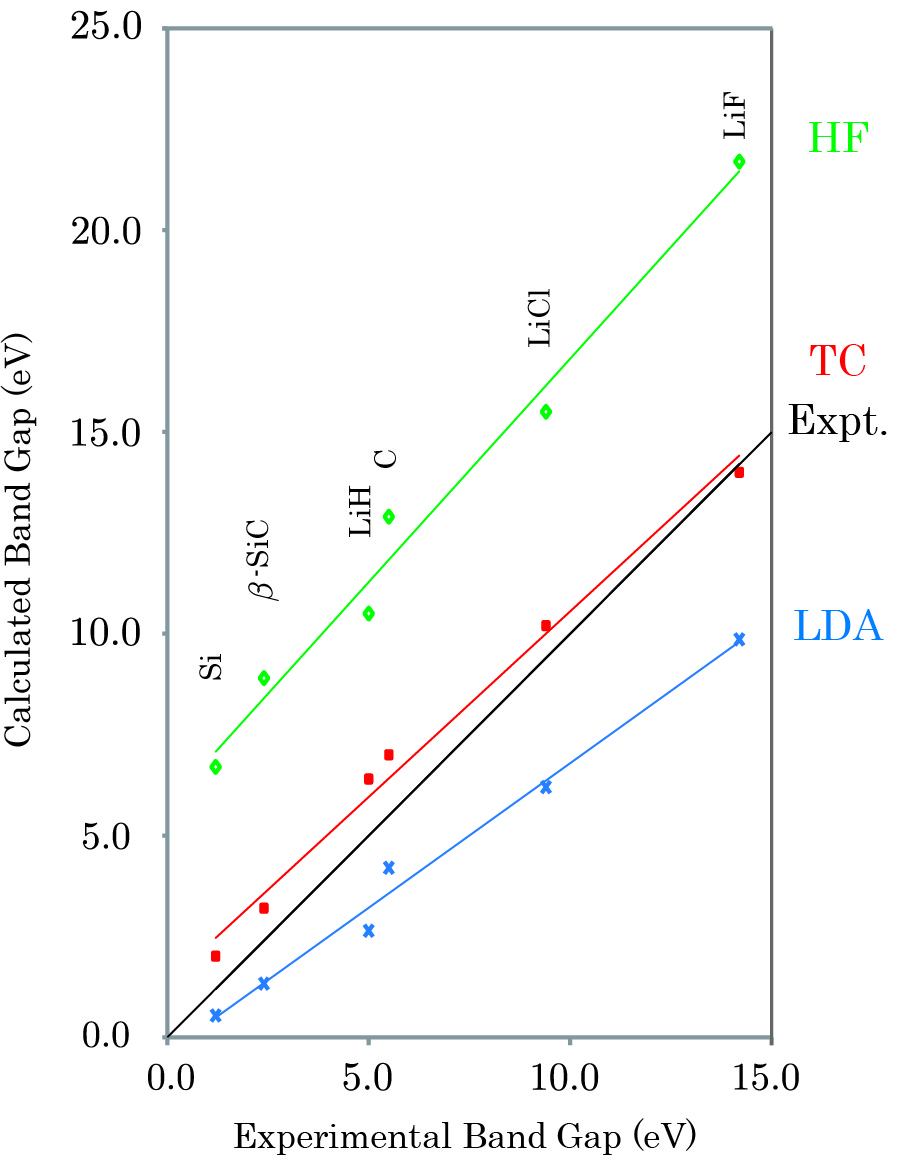Research
"Development of the transcorrelated method"
 One of the grand challenges in electronic structure calculations is the development of a highly accurate theory to obtain reliable information for correlated materials. Our approach explicitly employs a many-body wave function through the similarity transformation of the Hamiltonian with a Jastrow factor, which takes many-body correlation effects into account. Shrödinger equation is now transformed into an alternative correlated eigenequation. This method is called transcorrelated (TC) method. We have applied this method to various systems: atoms and molecules[1], uniform electron gas[2,3], solids[3], and a model system[4], and verified a great potentiality of the TC method. Recent development of an efficient algorithm for periodic systems[5] enabled us to perform TC calculations with modest computational cost. Using this algorithm, we have succeeded to improve the Jastrow factor[6], perform excited-state calculations[7], and combine the TC method with the many-body perturbation theory[8].
One of the grand challenges in electronic structure calculations is the development of a highly accurate theory to obtain reliable information for correlated materials. Our approach explicitly employs a many-body wave function through the similarity transformation of the Hamiltonian with a Jastrow factor, which takes many-body correlation effects into account. Shrödinger equation is now transformed into an alternative correlated eigenequation. This method is called transcorrelated (TC) method. We have applied this method to various systems: atoms and molecules[1], uniform electron gas[2,3], solids[3], and a model system[4], and verified a great potentiality of the TC method. Recent development of an efficient algorithm for periodic systems[5] enabled us to perform TC calculations with modest computational cost. Using this algorithm, we have succeeded to improve the Jastrow factor[6], perform excited-state calculations[7], and combine the TC method with the many-body perturbation theory[8].
One of the advantages of the TC method is that we can obtain one-electron energies with electron correlation effects while our approximation goes beyond a simple mean-field picture. Figure shows band gaps of several solids calculated with the TC method. We can see a great improvement for the TC method over conventional theories.
[1] N. Umezawa and S. Tsuneyuki, "Transcorrelated method for electronic systems coupled with variational Monte Carlo calculation", J. Chem. Phys. 119, 10015 (2003).
[2] N. Umezawa and S. Tsuneyuki, "Ground-state correlation energy for the homogeneous electron gas calculated by the transcorrelated method", Phys. Rev. B 69, 165102 (2004).
[3] R. Sakuma and S. Tsuneyuki, "Electronic Structure Calculations of Solids with a Similarity-Transformed Hamiltonian", J. Phys. Soc. Jpn. 75, 103705 (2006).
[4] S. Tsuneyuki, "Transcorrelated Method: Another Possible Way towards Electronic Structure Calculation of Solids", Prog. Theo. Phys. Suppl. 176, 134 (2008).
[5] M. Ochi, K. Sodeyama, R. Sakuma, and S. Tsuneyuki, "Efficient algorithm of the transcorrelated method for periodic systems", J. Chem. Phys. 136, 094108 (2012).
[6] M. Ochi, K. Sodeyama, and S. Tsuneyuki, "Optimization of the Jastrow factor using the random-phase approximation and a similarity-transformed Hamiltonian: Application to band-structure calculation for some semiconductors and insulators", J. Chem. Phys. 140, 074112 (2014).
[7] M. Ochi and S. Tsuneyuki, "Optical Absorption Spectra Calculated from a First-Principles Wave Function Theory for Solids: Transcorrelated Method Combined with Configuration Interaction Singles", J. Chem. Theory Comput. 10, 4098 (2014).
[8] M. Ochi and S. Tsuneyuki, "Second-order Møller-Plesset perturbation theory for the transcorrelated Hamiltonian applied to solid-state calculations", Chem. Phys. Lett. 621, 177 (2015).